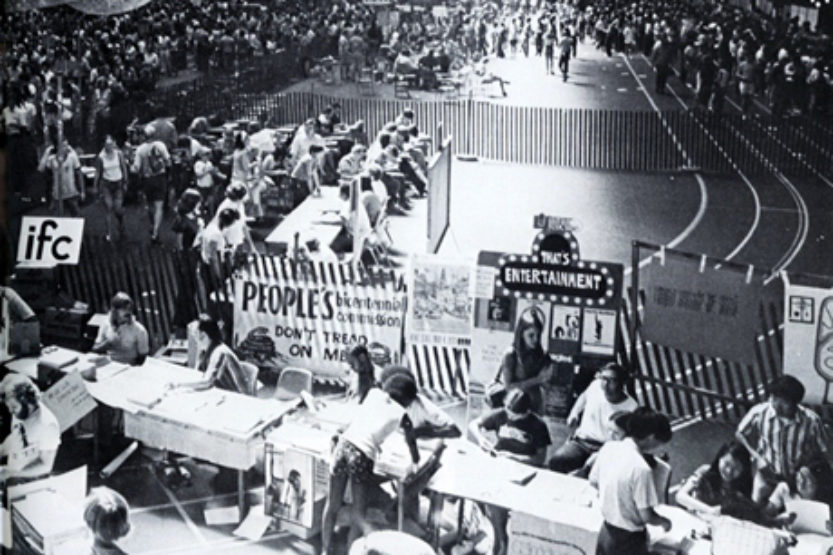Memory Lane: Registering for classes in a pre-internet era
 Confusion in the Armory, prior to the days of signing up for courses online.
Confusion in the Armory, prior to the days of signing up for courses online. “I have an 8 a.m. English; does anybody have a 9 a.m.?”
Before the days of point, click and done, registering for classes at the University of Illinois went something like this:
“All I saw before me was
a blur of people.”
“It took me four hours – I still didn’t get what I wanted.”
“I was mad at everyone … I just
felt like walking out.”
–1973 Illio
A far cry indeed from today’s would-be scholars, those fortunate beneficiaries of the digital age, where class signup involves a cool 15 minutes with a computer. In the not-so-distant past (before going online in 1995), UI student registration was a much sweatier proposition, with combatants navigating a chaotic maze of lines, tables and fences, braving a mad round robin in the unair-conditioned and cinder-floored Armory.
Add in the shouting, laughing, bullhorns, police, Frisbees, roadblocks, solicitors, confusion and people fainting in the heat – and you understand why, the further back you go, registration remains a vivid – and most unforgettable – memory.
700,000 punch cards
Joseph Rank ’69 MEDIA, MS ’73 MEDIA, senior adviser and former vice president of membership at the UI Alumni Association, was employed as a student worker for registration during the 1960s. From a vantage point above the Armory floor, he says, student registration looked like Chicago’s Union
Stock Yards.
“These storm fences basically herded people,” Rank recounts. “You started at the southeast corner of the Armory, and you ended up at the northwest corner. It was like a big funnel.
“It was like going through the digestive tract.”
Using hard-copy course guides as thick as phone books, students would outline a schedule, obtain their advisers’ authorizations and then, at the appointed time, go to the Armory “with hordes of people,” says Ruth Cortright ’62 FAA, EDM ’67. “And you went to the class that was the most popular, and you stood in line for that one first.” Sometimes you could beg and plead your way into a closed section; if not, you’d be back at square one if you didn’t have an alternate plan.
“People tried to [trade] class cards,” recalls Becky Wauthier ’82 LAS, ’82 LAS, associate registrar for academic records who was a student in the 1970s. She remembers students trying to beat the system auctioneer-style: “I have an 8 a.m. English; does anybody have a 9 a.m.?”
Things became less hectic in the late ’70s, when registration by mail reduced Armory crowds to only those students needing course changes. Still, before personal computers were brought in to aid the procedure in 1982, approximately 200 staffers took three days to process more than 30,000 student schedules. Helping to smooth the way were 16 IBM keypunch machines; 700,000 punch cards; 68 windows to collect tuition and fees; police officers; and roadblocks on Gregory Drive.
Unsweet Surrender
In those days, virtually every conceivable University-related problem was settled on the Armory floor. A “surrender center” at the January 1976 registration drew nearly 200 students at their wits’ end. One of them was a young man from Mississippi who had misinterpreted the benefits of the GI Bill. He had packed his bags and set out for
Illinois, only to learn in the Armory that he still needed to apply for admission.
“He has gone back to Mississippi to start over, with a good deal of obvious sympathy and shared frustration,” the report read.
At registration, students also received tuberculosis vaccinations, dealt with parking permits and insurance, and had their ID photos taken (perhaps accounting for the large number of frazzled-looking students recorded in that period).
But it wasn’t all tension and tears.
“I personally loved the Armory, especially fall semester,” says Barb Wood, now a retired assistant registrar for record services.“Kids had been gone all summer, and they were coming back, and they’d see people they hadn’t seen. Lots of hugs. It was quite a social event,” she says. “Sometimes I really miss that. Sometimes I feel like we’ve taken something away from people.”
Evensen is a freelance writer living in Champaign.

